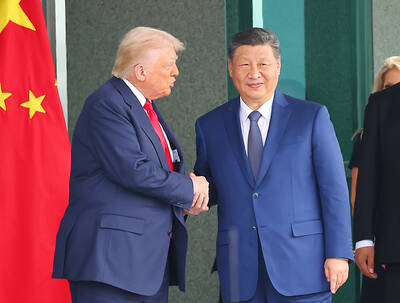Compal Electronics Inc (仁寶), the world’s second-largest contract PC maker, said yesterday it expects to see notebook shipments increase between 15 percent and 20 percent in the second quarter from last quarter’s 6.3 million units as the economy improves and contract order visibility increases to one-and-a-half months.
“For the month of May, we can see 80 to 90 percent visibility and for June somewhere around 60 to 70 percent visibility,” Ray Chen (陳瑞聰), Compal president told an investor conference yesterday.
The Neihu-based company yesterday booked 10.5 percent quarter-on-quarter growth for first quarter shipments or 3.2 percent growth year-on-year.
For the full year this year, Compal predicts a total of 32 million to 35 million units in notebook shipments, Chen said.
LCD GROUP
For its liquid-crystal-display (LCD) group, Chen yesterday forecast quarterly growth of between 10 percent and 15 percent for the second quarter, over the first quarter’s 67,000 units.
CULV NOTEBOOKS
As panel prices increase steadily over time, Compal expects its gross margin percentage to decline, but the value of the gross margin would remain unaffected, Chen said.
Chen said it is hard to see the impact now of the recent introduction of consumer ultra-low-voltage (CULV) notebooks by various companies, but perhaps by the fourth quarter, CULV notebooks could comprise 20 percent of the company’s global notebook shipments.
Chen also expected low-priced, Internet-enabled netbooks to take up between 25 percent and 30 percent of overall notebook volume, but he said he did not see Android-based notebooks becoming mainstream until the second half of next year at the earliest.
As netbook screen sizes increase this year to 11.6 inches, and are embedded with Menlo computer processing units, Chen said he believed this trend would affect approximately one-fourth of regular notebook sales at most, as regular laptop prices are dropping precipitously.
AVAILABILITY
Although the availability of various components was good, the executive said there could possibly be an LCD TV shortage, particularly for 32-inch and 37-inch screens.
“As LCD panel prices are starting to rise, notebook panels [availability] could tighten as demand picks up throughout the year and consumer demand increases sharply,” he said.
Last month, Compal posted a 13 percent year-on-year decline in first-quarter net profits at NT$2.80 billion (US$84.5 million), or NT$0.73 earnings per share.
Edward Yen (顏子傑), who rates the stock “buy” at UBS AG in Taipei, gives the company a price objective of NT$31.
Compal traded down NT$0.55 to NT$31.30 on the Taiwan Stock Exchange yesterday. The benchmark TAIEX inched up 0.09 percent.

RUN IT BACK: A succesful first project working with hyperscalers to design chips encouraged MediaTek to start a second project, aiming to hit stride in 2028 MediaTek Inc (聯發科), the world’s biggest smartphone chip supplier, yesterday said it is engaging a second hyperscaler to help design artificial intelligence (AI) accelerators used in data centers following a similar project expected to generate revenue streams soon. The first AI accelerator project is to bring in US$1 billion revenue next year and several billion US dollars more in 2027, MediaTek chief executive officer Rick Tsai (蔡力行) told a virtual investor conference yesterday. The second AI accelerator project is expected to contribute to revenue beginning in 2028, Tsai said. MediaTek yesterday raised its revenue forecast for the global AI accelerator used

TEMPORARY TRUCE: China has made concessions to ease rare earth trade controls, among others, while Washington holds fire on a 100% tariff on all Chinese goods China is effectively suspending implementation of additional export controls on rare earth metals and terminating investigations targeting US companies in the semiconductor supply chain, the White House announced. The White House on Saturday issued a fact sheet outlining some details of the trade pact agreed to earlier in the week by US President Donald Trump and Chinese President Xi Jinping (習近平) that aimed to ease tensions between the world’s two largest economies. Under the deal, China is to issue general licenses valid for exports of rare earths, gallium, germanium, antimony and graphite “for the benefit of US end users and their suppliers

Dutch chipmaker Nexperia BV’s China unit yesterday said that it had established sufficient inventories of finished goods and works-in-progress, and that its supply chain remained secure and stable after its parent halted wafer supplies. The Dutch company suspended supplies of wafers to its Chinese assembly plant a week ago, calling it “a direct consequence of the local management’s recent failure to comply with the agreed contractual payment terms,” Reuters reported on Friday last week. Its China unit called Nexperia’s suspension “unilateral” and “extremely irresponsible,” adding that the Dutch parent’s claim about contractual payment was “misleading and highly deceptive,” according to a statement

Artificial intelligence (AI) giant Nvidia Corp’s most advanced chips would be reserved for US companies and kept out of China and other countries, US President Donald Trump said. During an interview that aired on Sunday on CBS’ 60 Minutes program and in comments to reporters aboard Air Force One, Trump said only US customers should have access to the top-end Blackwell chips offered by Nvidia, the world’s most valuable company by market capitalization. “The most advanced, we will not let anybody have them other than the United States,” he told CBS, echoing remarks made earlier to reporters as he returned to Washington